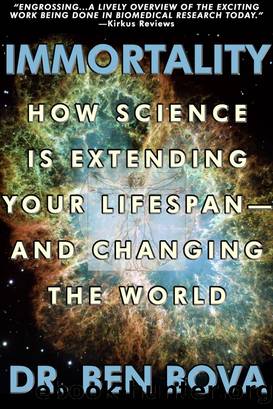Immortality by Ben Bova

Author:Ben Bova
Language: eng
Format: epub
Tags: aging, immortality, antiaging, rejuvenation, life extension
Publisher: ReAnimus Press
Eternal Youth?
The telomeric explanation is based on the proposition that we age because our cells age, and our cells age because their telomeres shorten.
If that is true, if telomeres really are the cellular clock that determines the rate at which we age, then it might become possible to reset the clock—or even stop it altogether.
Researchers have essentially stopped the telomeric clock in human cells in a laboratory culture dish. They have found that adding telomerase to the cells rebuilds their telomeres after cell division and allows the cells to reproduce continuously without a Hayflick limit. Telomerase rebuilds the telomeres, like a molecular railroad construction crew laying down new track. The cells no longer age. But they don’t become any younger than they were to start with. While young cells remain young, old cells stay old.
Although we do not yet know how to reset the clock of aging and make old cells young again, it appears that by feeding the cell telomerase, we can stop the clock from ticking.
How to get the telomerase into the cell?
Although most of the body’s cells do not produce telomerase, the gene for its production is present in every one of the 100 trillion cells of your body. If we could get the cells to express that gene and make telomerase when we need it, we could halt the inexorable advance of aging.
While not actually a Fountain of Youth, it would be at least a reprieve from senescence and death. (Again, assuming that the telomeric explanation of aging is correct.)
Yet the fact that most of our cells do not produce telomerase naturally gives pause. Is there a reason for this churlish behavior? There must be. More on that shortly.
For now, let us consider other ways to get telomerase into our aging cells. It is easy enough to inject the enzyme into cells in a culture dish—under controlled laboratory conditions. But the living human body is another matter altogether. Telomerase is a rather fragile chemical, easily broken up. The enzymes in the body’s blood would destroy injected telomerase before it got the chance to start working.
Biochemists are clever people, though. It might become possible to develop an artificial, man-made form of telomerase, tough enough to withstand the body’s defense systems while still maintaining the essential characteristics of natural telomerase: the ability to rebuild telomeres.
Such a synthetic telomerase (or telomerase analog, to use the biochemists’ jargon) could be injected into the bloodstream without being broken down; it could get to the cells to rebuild telomeres. Similar analogs have been developed for antibiotics, steroids, and other therapeutic drugs.
Most likely, telomerase analogs would be specific for certain types of cells, rather than a broad-band medication that would affect the entire body. For example, a specific telomerase analog for resetting the clocks of blood vessel cells might reverse the effects of atherosclerosis, thereby preventing heart disease.
Another way of getting active telomerase into the body would be to engineer genes that produce telomerase. If your own somatic cells won’t do the job, insert new genes that will.
Download
This site does not store any files on its server. We only index and link to content provided by other sites. Please contact the content providers to delete copyright contents if any and email us, we'll remove relevant links or contents immediately.
The Hot Zone by Richard Preston(1632)
Rigor Mortis by Richard Harris(1384)
How Innovation Works by Matt Ridley(1277)
Oxymoronica by Dr. Mardy Grothe(1217)
Mawson's Will by Lennard Bickel(1146)
Kathryn Bowers & Barbara Natterson-Horowitz by Zoobiquity(1105)
The Future of the Mind: The Scientific Quest to Understand, Enhance, and Empower the Mind by Michio Kaku(1090)
Bankrupting Physics by Alexander Unzicker(1080)
The Ghost Hunters by Deborah Blum(1056)
Statistics Done Wrong: The Woefully Complete Guide by Alex Reinhart(1048)
One Two Three ... Infinity: Facts and Speculations of Science by George Gamow(1003)
The End of Breast Cancer by Kathleen T. Ruddy MD(999)
THE DEMON HAUNTED WORLD by Carl Sagan(997)
Science Book by Big Ideas Simply Explained(962)
The Universe Speaks in Numbers by Graham Farmelo(959)
The Wizards of Langley by Jeffrey T Richelson(878)
Rigor Mortis: How Sloppy Science Creates Worthless Cures, Crushes Hope, and Wastes Billions by Richard Harris(866)
Biomimicry by Janine M. Benyus(856)
The Case Against Fragrance by Kate Grenville(834)
